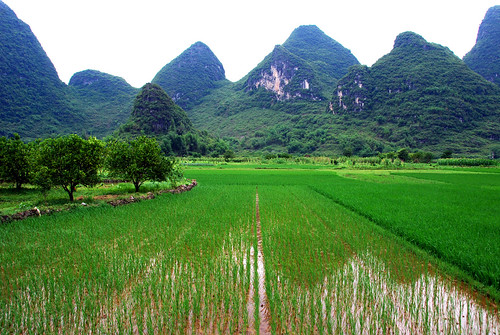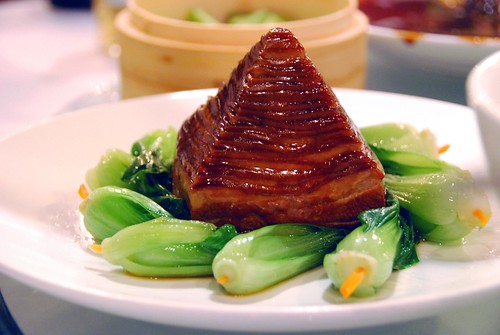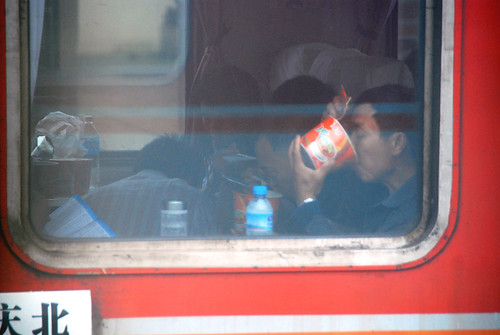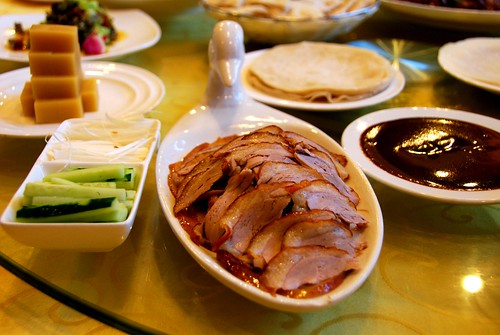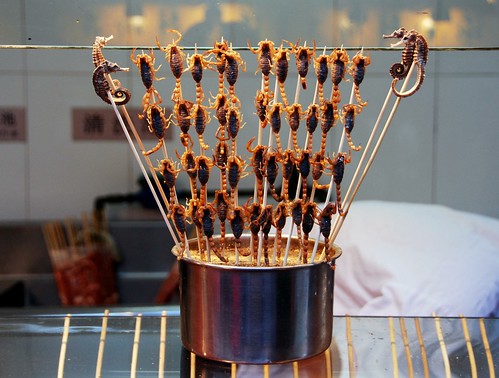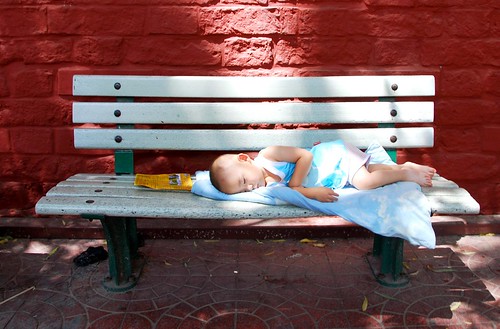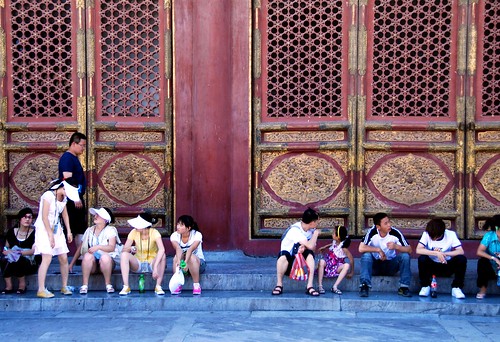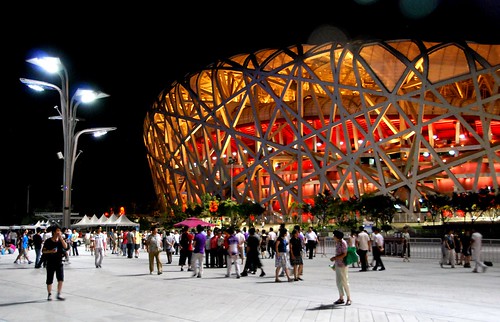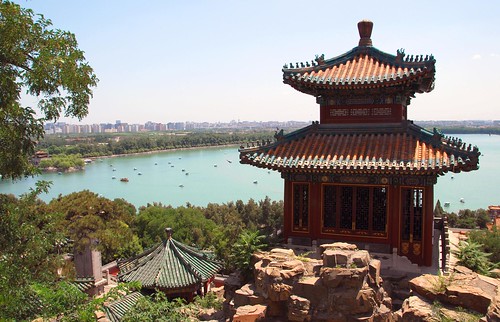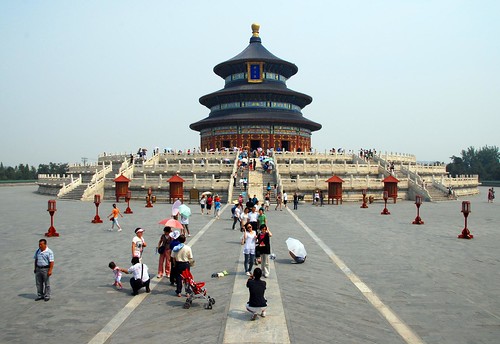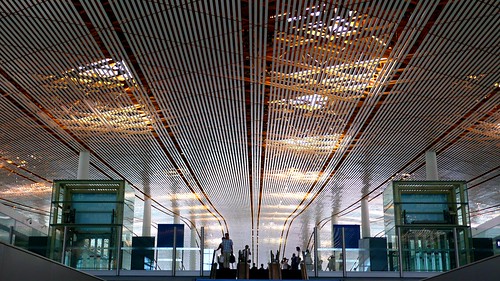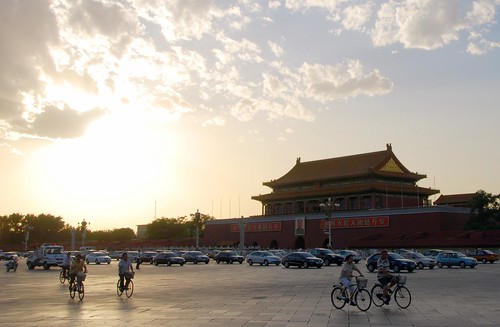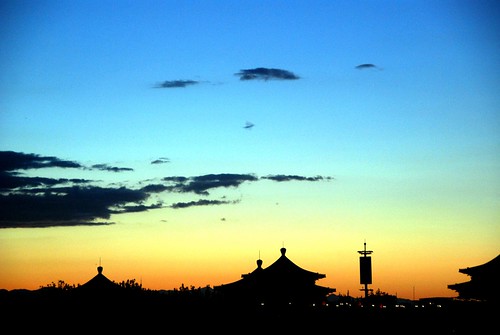Posts Tagged ‘Beijing’
Oh, the highs and lows of traveling through China! There were definitely some lows (see Qingdao: Confronting Identity in a German Town in China and Yangshuo: Anatomy of a Scam), but the peaks and the valleys seem to flow into one another so that you’re no longer sure what hurts so bad and what hurts so good. Our Yangzi Three Gorges River Cruise is the perfect metaphor: we spent three days on a 4th class river boat with a bunch of half-naked Chinese people who only stopped smoking cigarettes, spitting, and playing mahjong long enough to follow a megaphone-wielding tour guide around in 100 degree heat. Yes, it was unpleasant at the time. But even now, almost 3 months after the fact, we bring it up in conversation almost every week and giggle at the absurdity of it all. It’s sort of like running a marathon: when you’re in the moment, you can feel blinded by the pain, but once it’s over, you’re really glad you did it.
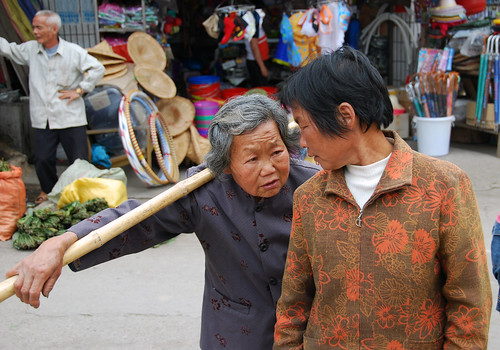
Ladies at the market near Hakka House.
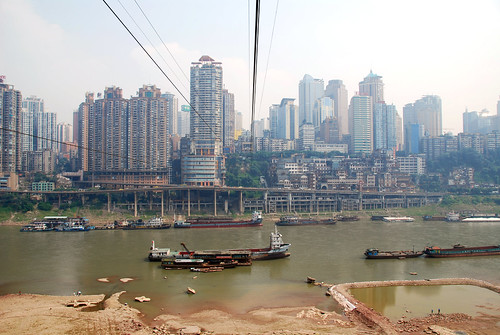
View of Jiefangbei from across the Jialing River in Chongqing.
As Jeremy put it, “of all the countries we’ve been so far, China is the one I would have most regretted missing.” China is relevant, y’all. It is freaking fascinating there right now, a place where nothing stays the same for more than a few weeks, the government is still messing with people’s civil liberties in exchange for making them rich, and people are spitting on the street in their US$500 Gucci heels. We think every Westerner should go. Observe. Learn. And see what a country of 1.3 billion people all working together to pull their country up by its bootstraps looks like. There’s no place like it.
Days spent here: 43 (26 days in Southern and Central China, 17 days in the North)
Highlights: Huangshan, Yangshuo (for Jeremy), Yangzi River Three Gorges Cruise (somewhat painful, but also unforgettable), Beijing
Places we would like to visit next time: Western China (i.e., Tibet, Xinjiang, Jiuzaigou) and Mongolia
Average daily expenditures (for two people): US$213 for 13 days on our 5 star hotel/fancy eating tour with my parents (heavily supplemented by Jack and Wendy—thanks Mom and Dad!), US$120 for the remaining 30 days on our usual 1 star hotel/street food backpackers tour
Prices: China’s pretty reasonable. Food is very inexpensive (from US$5-10 per person per meal) and accommodation can be pretty cheap too. On average, we paid about 200 RMB (approx. US$30) per night for a double room ensuite. We used hostelbookers.com and Ctrip.com to book our accommodation, and we got great deals using both websites.
Weather: Do yourself a favor and don’t visit northern China in June or July, unless you like your searing heat with a dash of crushing humidity. Don’t say we didn’t warn you.
Language: There are 300 million people in China learning English right now—that’s the same number of people that live in the US! But you wouldn’t know it from traveling in this country. If you don’t speak Mandarin, polish your pantomiming skills before you go. On the other hand, if you are a wai guo ren with Mandarin speaking skills, prepare to be worshipped. The people will fall all over themselves with delight.
If you do speak Chinese, be warned that you will need to overcome not only regional accents, but regional phrases as well (ex. if you are from Taiwan, you will call a spoon a tiao gen, but a Beijinger will refer to it as a shao zi). For instance, I had the following conversation with a person in Taishan (in Chinese, of course):
Hope: Excuse me, do you know if there is a pharmacy around here?
Random Person: A what?!? A pharmacy?
H: Yes, a pharmacy.
RP: I don’t know. Why don’t you go ask over there [points to a pharmacy], at the medicine store?
Oh yeah, and if you’ve ever been interested in visiting China, go now, before all the Chinglish gets wiped out.
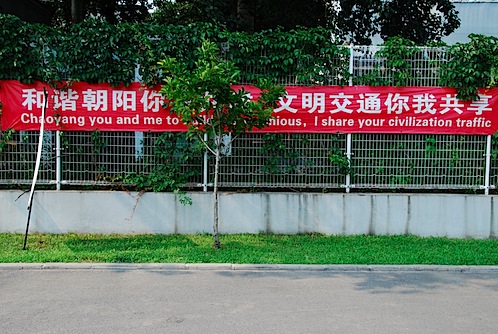
One day, China will be void of gems like this (reads: Chaoyang you and me to build harmonious, I share your civilization traffic)
Food: Outside of our eating tour with my parents and the food in Beijing, we weren’t too impressed with Chinese cuisine. We said it before and we’ll say it again: if you want the best Chinese food in the world, go to Taiwan.
That being said, China is a great place if your culinary hero is Anthony Bourdain. We got over ourselves really fast in Chongqing, where my aunt’s friends took us out to meals involving pig brains, duck tongues, cow rumen, and various other intestinal elements. You can also try snake, turtle, or live scorpions. Yum?
Transit: China’s got a pretty good rail system for such a big country. Chinese trains are not quite as nice as the trains in Taiwan or Japan, but they’re not as bad as the trains in Vietnam, either. For long journeys, you can purchase tickets for a soft sleeper (most expensive), hard sleeper, soft seat, or hard seat (cheapest). Soft sleeper trains are pretty nice, with 4 beds in each room, AC, clean sheets, and relatively clean bathrooms. “Hard sleeper” sounds scary, but it’s worth noting that hard sleeper beds aren’t hard—the mattress is just a little bit thinner. The biggest difference is that there are 6 beds in the hard sleeper rooms rather than 4. Since J and I are tall, we usually traveled in the soft sleeper trains, which are still relatively cheap, even though tickets are 1.5-2 times as much as the hard sleeper carriages.
For information on routes, schedules, and prices, check out ChinaTravelGuide.com’s fabulous online train schedule database.
The bigger cities like Shanghai and Beijing have subways, but Shanghai’s subway system has pretty bad signage and confusing connections. Beijing’s subway did not reach most of the sites in the city center, so we did a LOT of walking or took taxis. Luckily, taxis are very cheap in China’s capital city, but you’re going to have to speak Mandarin in order to get where you want to go.
Internet: Web access is great all over China—as long as the government isn’t blocking the site you want to surf. YouTube, Flickr, Facebook, Twitter, and all blogspot sites got blocked for periods of 3-10 days while we were in China due to the 20th anniversary of Tiananmen Square and the deadly Uighur protests in Xinjiang. Annoying.
Culture: Get ready for a culture shock. Get ready for people constantly cutting in front of you in line. Get ready for men walking around in inappropriate places with their shirts hiked up above their nipples. Get ready for spitting. Get ready for half-naked babies pooping in the street. Get ready for smoking. Get ready for LOUD. That being said, once you figure out how things work, it’s easy enough to deal with them.
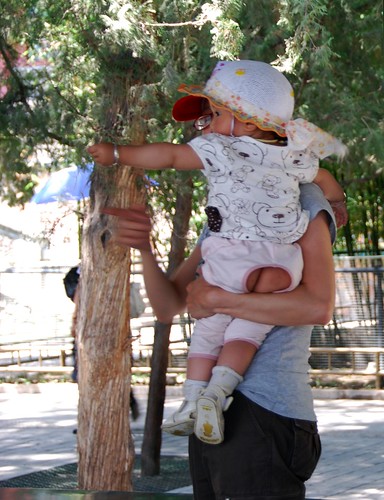
Baby at the Summer Palace wearing the poop pants.
One fascinating thing about traveling through Taiwan and China is that we got a firsthand look at how differently these two countries developed culturally. The Taiwanese are exceedingly polite, aggressively helpful, and overly concerned about safety. The Chinese on the other hand, are rude and pushy, frequently uninterested in helping you, and some of the craziest drivers in the world. Now, you could point to many reasons for this cultural gap: the fact that it was the intellectuals and people of the upper classes that moved to Taiwan in 1949 to escape Communist persecution, the effect of 60 years of Communist rule on the people of China, etc. But I’d like to propose a different hypothesis: It’s the sheer numbers. There are 57 times as many people in China as Taiwan. You would get CRUSHED in China if you were nice and helpful to people all the time. The result is, if someone vouches for you in China (as my aunt did, in our case), you get extreme, excessive kindness from people that you may only marginally know you. But those same people on the street may wave you off if you ask for help. Yes, it’s a contradiction. But it’s a fact of life here. All I can say is, try to make friends with a local. If you do, you will get the red carpet rolled out for you.
In short: It’s not always pleasant, but that doesn’t mean it’s not a great time.
Since I already wrote a book about your typical homestyle Northern Chinese fare when we were in Taiwan, I’m not so much going to explore the What (as in What is good) of Beijing cuisine, but rather, the Where (as in Where we ate). The food in Beijing is the best we had in China (though to be honest, the best Chinese food is still over in Taiwan).
First things first: China is a huge country, and there are many regional differences in speech, appearance, and yes, diet. But there is one major difference between the north and the south when it comes to cuisine: the north is all about noodles, and the south is all about rice. This is a common explanation for why people in the north tend to be taller than those in the south (take a wild guess where my freakishly tall family is from). I’m not exactly sure why a noodle-based diet would result in a taller population, but if I had to take a guess, I suppose it’s the egg protein in the noodles. Anyway, because meat was more scarce in the past, and because people in the south eat rice as their carb, southern cuisine tends to be very oily. Hey, people need to get their calories somewhere.
This could be the reason why J and I preferred food in the north. Our Northern California palettes prefer light and fresh over heavy and rich. This is not to say we don’t like rich foods—after all, I wouldn’t exactly describe ramen as “light and fresh.” Rather, we just like our food to taste like itself (we want spinach to taste like spinach and not like oil).
That being said, we ate a whole lot of stuff that tasted like Peking duck while we were in Beijing. ![]()
Our first taste of Peking duck was our meal out with my aunt and uncle at our hotel’s (King Parkview Hotel) adjoining restaurant, which, surprisingly, turned out to be quite good! I’ve had Peking duck in the States before, but it is totally different experience in Beijing. The process begins by choosing a duck, and then a person that I can only describe as a duck surgeon comes out and carves your bird into paper-thin slices.
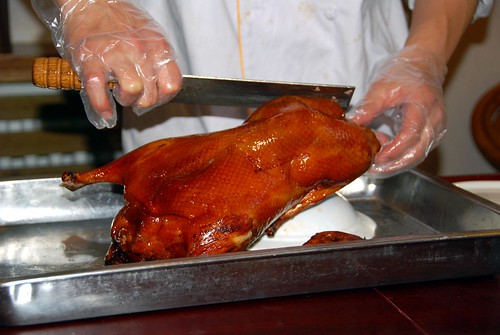
The duck surgeon hard at work in the King Parkview Hotel Restaurant.
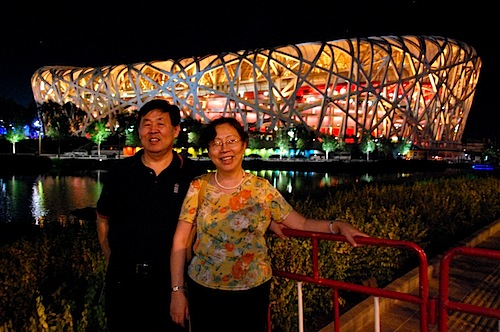
My aunt (daughter of my Nai Nai’s older sister) and uncle in front of the Bird’s Nest. Aren’t they cute?
The paper-thin slices of Peking duck are then usually sandwiched between a small piece of bread with some hoisin sauce and additional goodies. In the States, these “additional goodies” consist of spring onion (bo-ring!). But Beijing puts the “good” in “goodies,” as at Hua Jia Yi Yuan on “Ghost Street” or Gui Jie (one of the most famous eating streets in Beijing), where you get all kinds of fun treats, like cucumber, pickles, even pineapple!
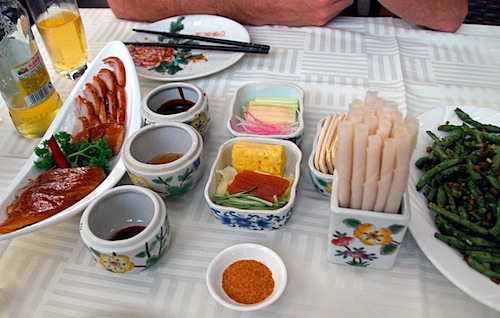
Hua Jia Yi Yuan’s Peking duck toppings.
Gui Jie has a lot of courtyard restaurants, and the atmosphere is fantastic.

The interior of Hua Jia Yi Yuan.
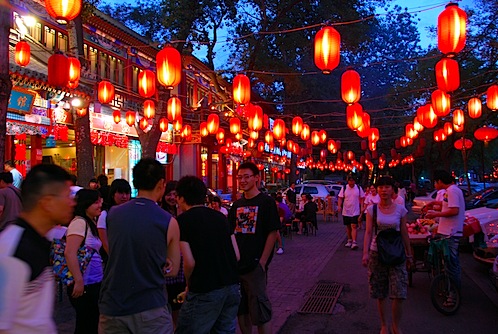
Red lanterns add to the atmosphere on Gui Jie.
We also ate at one of the most popular Peking duck restaurants in all of Beijing: Dadong Duck Restaurant. Our verdict? Unremarkable and overpriced, though you do get free drinks while you are waiting for your table. That’s all we have to say about that.
We enjoyed many a meal by Qian Hai Lake (also sometimes called Hou Hai–the two lakes are adjoined so you can refer to it by either name). Very touristy, but if you look hard enough, you can find budget restaurants. The evening light on the lake is really beautiful, and you can watch locals go for a dip in the water.

Locals taking a dip in Qian Hai at sundown.
Not all of our meals out consisted of Peking duck. We also had some good, old fashioned jiao zi (dumplings). The best place we ate (by far) was a small shop called Xia’r Lao Man (translation: “Filling Always Full” or “Stuffing Always Stuffed”), where we had jiao zi with pork and fennel stuffing (yum), and an incredible liang ban (cold salad) of cabbage, bean sprouts, cilantro, sesame oil, garlic, and peanuts.
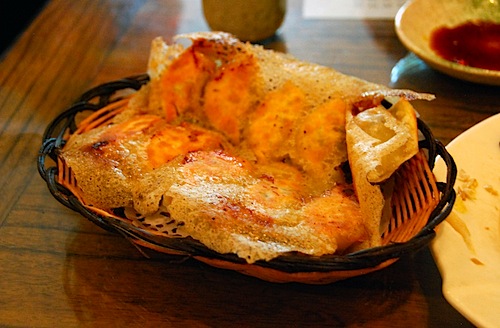
Pork and fennel guo tie (potstickers). They come out of the kitchen like this, the dumplings connected by a solid sheet of fried. Mmm…fried…
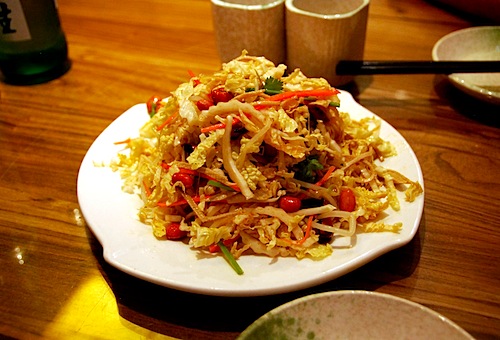
Lao man’r liang ban salad. So refreshing on a hot summer day!
Beijing food just can’t compare to the weirdness of some of the food we ate in the south, or the scariness of the food in Chongqing, but they sure try hard to compete on Wangfujing snack street, where you can get LIVE scorpions on a stick (seriously, they wiggle around on there), topped off with a seahorse.
Of course, if you’re longing to live on the wild side without risking a scorpion sting, you can always order “The palace explodes the diced chicken.”
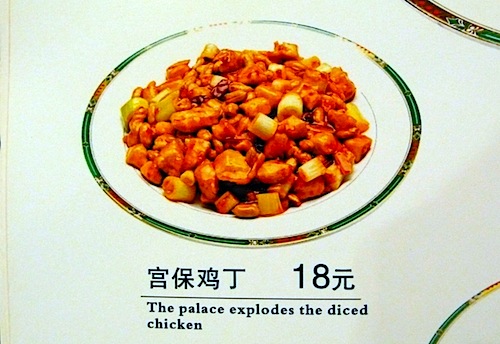
Or impress your friends by telling them you ate the little-known “Agrocgble aergerita.” With fish heads, of course.
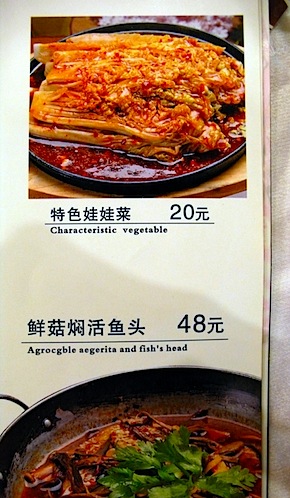
One thing you have to give the Chinese credit for: they don’t hide anything. Part of it is that so much of their lives are lived outdoors. Just walk around the city, and you’ll see so many little intimate moments that are a part of everyday life around here.

How many more minutes until the end of my shift?
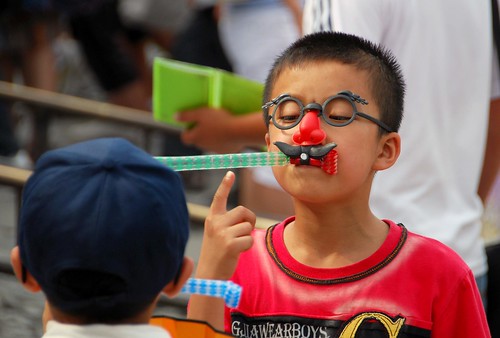
Two brothers square off in Groucho glasses.
One thing that really impressed us here at 12FOOT3: Chinese people really know how to use public spaces. Everywhere you look in Beijing, there are people hanging out, talking, sitting in the shade, playing with the grandkids. I mentioned in our last post that we were charmed by a Sunday spent in the Temple of Heaven Park watching hundreds of people mingling about, doing their Sunday thing (which included ballroom dancing, playing games, singing, hacky sack, calligraphy, and more).
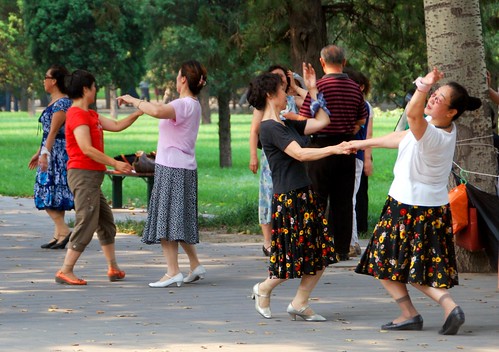
Women ballroom dancing in the park. How cute is it that the two on the right are wearing matching skirts?
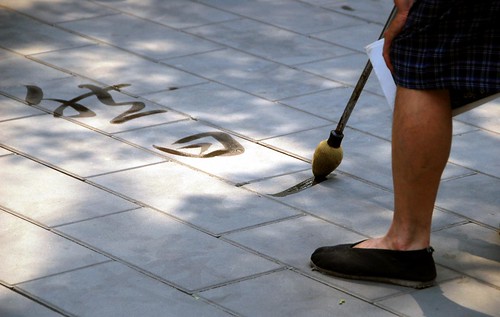
Practicing calligraphy in the park.
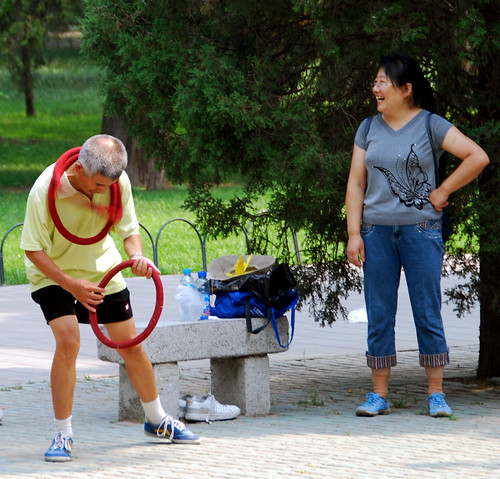
Playing “catch-the-ring.” You play the game in pairs—your partner throws three soft rings from about 100 yards away, and your objective is to catch them around your neck.

As far as we could tell, it seemed like this woman just showed up in the park with a full band, and people wandering through the park spontaneously gathered around them to sing traditional Chinese songs (I even recognized a few from my Dad’s karaoke hits!).
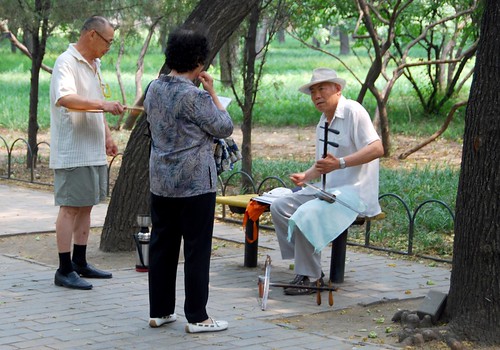
A more intimate version of the big brass band pictured above: just one musician and his dedicated singer.
The other reason why it’s all on display in Beijing is that Chinese people just have different notions of privacy than we do in the west.
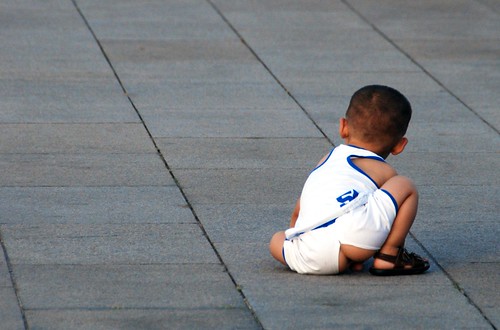
Yes, kids are still wearing the split pants around Beijing. Though I saw a LOT fewer kids wearing these in Beijing than I did in 2000.
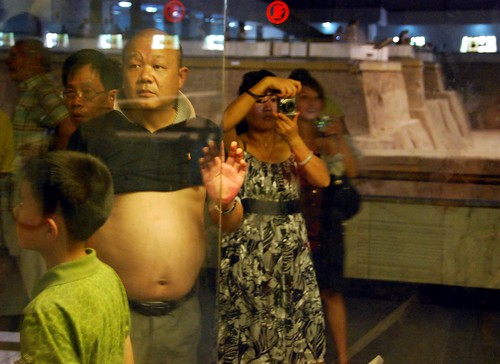
OK, this particular photo was actually taken in Xian, but you see these big Buddha belly guys walking around EVERYWHERE. And I mean everywhere—museums, hotel lobbies, fancy restaurants…
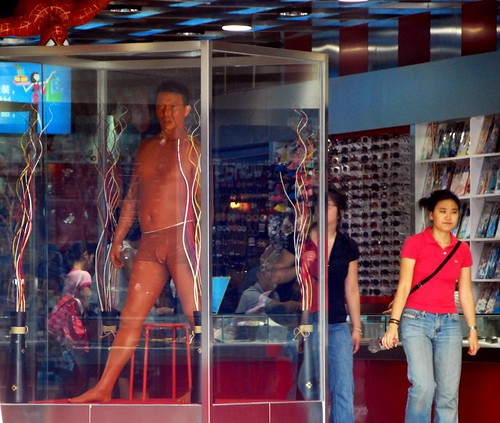
Um, we don’t really know what’s going on here either.
Things HAVE changed around here since the Olympics. For one, people don’t stare…as much (don’t worry, they still stare). I guess they got their fill of wai guo ren’s in 2008. And it does seem that things are a little less raw around the capital city than they were in 2000. There are public bathrooms every two blocks, and they are clean! But the important thing is: the Beijing flavor is still there, and it seems that the Olympics just served to elevate this beautiful city to a more international/cosmopolitan level.
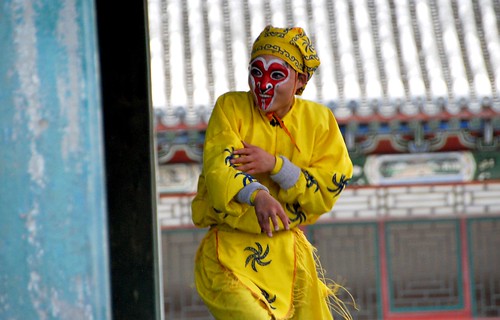
Chinese acrobat at the Summer Palace.
Note: There is a LOT to see and do in Beijing. I mean, it’s almost ridiculous. Not only are there incredible modern and historical buildings to tour, but the culture in China’s capital city is rich and full of life. So for this special city, we’ll be taking a different approach. In a 3-part series, we’ll be sharing the sights, the people, and the food of Beijing with you. We’ll go heavy on the photos and light(er) on the commentary.
If China had a motto, it would be “Go big or go home!” So it makes sense that the sights around China’s capital city are massive. Parks, palaces, walls…you name it, they are share one thing in common: they’re Big (that’s capital “B” Big).
The Forbidden City did not fail to impress, even the second time around (for me, it was the first time for Jeremy). Unfortunately, we showed up at about 10:30AM, which is when most of the tour groups arrive, so our visit was characterized by pushing crowds and tour guides with microphones turned up to “11″ (no fun for my noise- and crowd-averse husband). Here’s a tip: if you ever visit the Forbidden City, go around noon when the tour buses take the masses off to lunch. When we were through checking out the palace grounds, we happened to walk back through the compound (instead of exiting the north side) and NO ONE was around.
Beijing is another city (along with Chongqing and Shanghai) where we have family, and after dinner of Peking duck with my aunt and uncle one night (more on this in the next post), they drove us out Olympic Park. It was really exhilarating to see these gorgeous buildings in real life, especially since Jeremy and I got chills watching the Opening Ceremonies last year on TV. We got really lucky and happened to go on an event night, when the lights were on (apparently the Bird’s Nest and Water Cube are not usually this colorful).
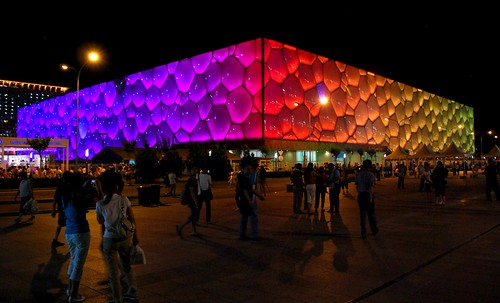
The Water Cube during a rainbow moment. The building’s “skin” is constantly changing color.
When my uncle heard that we planned to visit Simatai (a remote part of the Great Wall) the following day, he arranged for his driver to take us, which was really fortunate for Jeremy and I because it would have taken a LONG time to get there on public transport. Last time I went to the Great Wall, I only saw Badaling, a very touristed part of the wall. Simatai was virtually empty, and we had glorious weather out there: blue sky, fluffy clouds, and a light breeze to cut the summer humidity. Seriously folks, it looked like New Zealand out there!
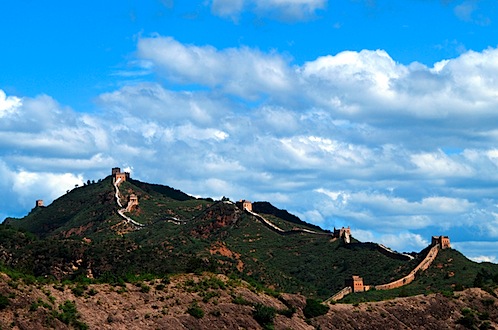
Yes, we had amazing blue skies while we were in Beijing, but Oh. My. God. Was it Hot. So Hot I’m using a capital “H” to describe how Hot it was. The day we visited the Summer Palace (the place where the Empress hung out when it got too scorching in the city), we couldn’t make it more than 10 minutes before taking a break to suck down some water or eat an “Old Beijing popsicle.” They don’t sound that appetizing, but they are cold, sweet, and only cost 1 RMB. We must have eaten at least 6 of those while we were at the Summer Palace.
As for the Palace itself? Impressively large, but a bit over-restored for my tastes. Call me nostalgic, but I like my old things to look old.
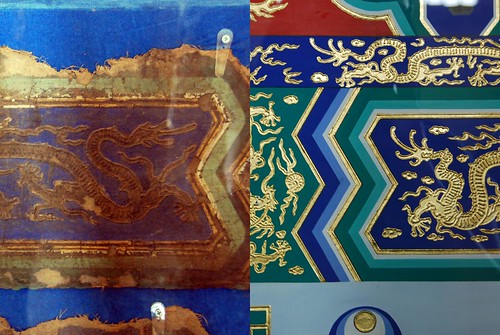
Before and after restoration photos of the paintings around the Summer Palace.
The sprawling Temple of Heaven Park (Tian Tan) was a love/hate thing for us. We adored all the locals hanging out in the park dancing, singing, playing games, and practicing calligraphy, but once we got to the actual tourist destinations (like the Temple of Heaven itself), the tourist crush started up again. Unless you’re really into Chinese architecture, just hang out in the park and soak up the ambience, and skip the actual temples.
Beijing has some wonderful outdoor public spaces. Our hotel was located right next to Jing Shan Park, so we walked through a couple of times to enjoy the fading light over the capital city.
When we weren’t touring “sights” or hiding under the air conditioning of our hotel room, J and I just wandered: in and out of Beijing hutongs, around the shops and restaurants of Houhai or Qianhai lakes, and up and down main thoroughfares, taking in this city of perpetual movement.
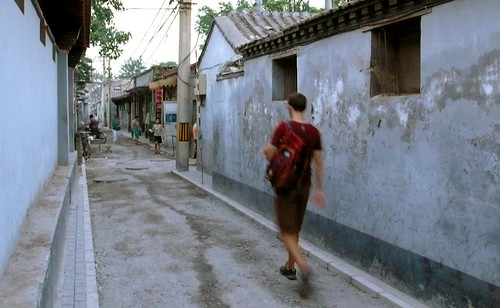
Walking to dinner in the fading light of a Beijing hutong.

Evening boat jam in Houhai Lake.
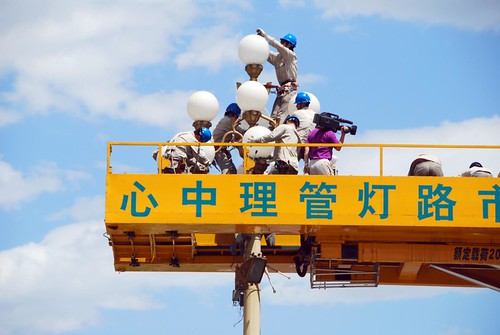
How many Chinese people does it take to change a light bulb?
To be clear: It’s not that Jeremy and I were hesitant about returning to China, but I wouldn’t say that we were excited about it either. It’s always a bit of a downer leaving a country you really enjoy, and after our rude transition from magical New Zealand to Australia, we knew we had to prepare ourselves mentally for our return to the People’s Republic. So we visualized putting our smog goggles back on, honed our elbow reflexes so we could successfully fend off any would-be line cutters, and dusted off the ear plugs.
And then, we saw this from the plane:
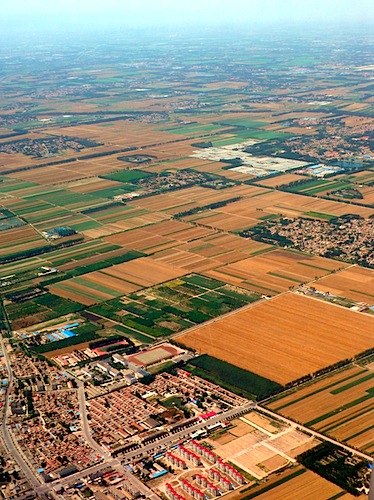
View of the Chinese countryside outside of Beijing.
I told Jeremy, “the airport is really far outside the city, so I bet we’re still outside the smog bank.” Memories from my visit to Beijing in 2000 are clouded by a thick grey cast over the city and the matching tissues when I blew my nose, so I was understandably a bit skeptical.
As we landed, we were told that the Quarantine Authorities would be coming through to check everyone’s temperatures before we deboarded. I tucked in for a long wait at the gate, but true to Chinese efficiency, three QA’s in haz-mat suits got on, shot everyone in the face with a temperature gun, and cleared us to deboard faster than you can say “H-yi-N-yi” (that’s H1N1 in Mandarin).

A quarantion authomite taking face temps on the plane.
We wandered through Beijing’s gorgeous new terminal 3 towards immigration, where the friendly officer spoke to me in perfect English (that was weird…speaking to a Chinese person in English) and marveled at the collection of stamps in my passport.
After quickly clearing immigration, we boarded the comfortable train into town. Less than an hour later, we were headed towards our hotel under gloriously clear skies.
OK, OK. HOLD UP! What is this?!? Nice people, efficient bureaucracy, uncrowded public transport, AND a smogless sky? Did we get off the plane in the wrong country? Is someone playing a really, really mean trick on us?
Well, guess what…all those driving restrictions and factory shut-downs that Beijing put into place for the 2008 Olympics have finally paid off. The sky was crystal clear for our entire 5-day stay in the capital city. I can’t tell you what a difference a blue sky in Beijing makes…our hearts soared, our eyes delighted, and we felt more in tune with this city than any other in China.
We ended that first day with a long walk to watch the sunset in Tiananmen Square. There were police guards all around and you couldn’t loiter at all at the entrance to the Forbidden City. But hey, we’ll trade some subtle military intimidation for a blue sky any day.
